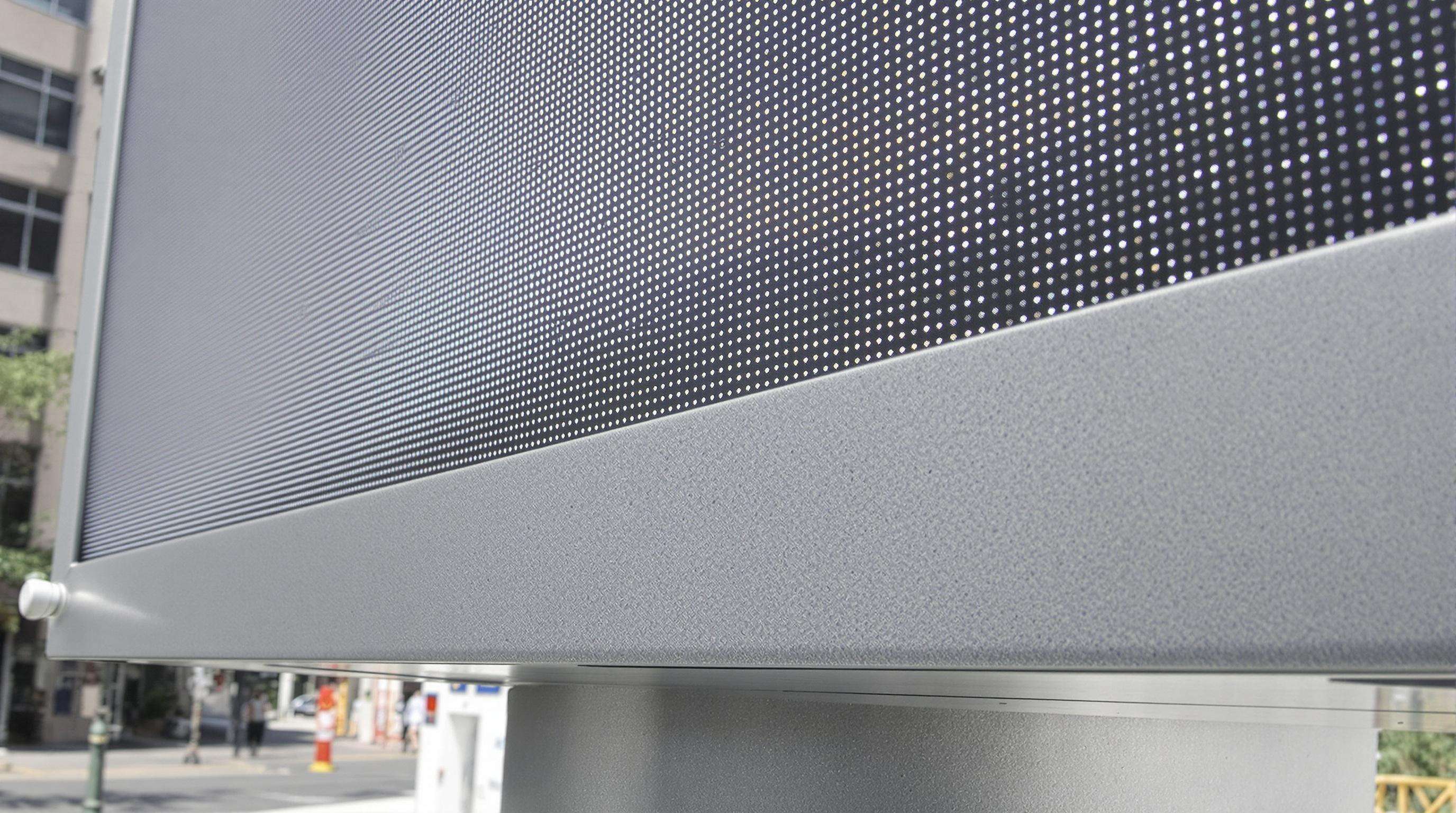니트 요구사항 야외 LED 광고판

실외 LED 간판은 햇빛을 견디기 위해 실내 디스플레이(600–1,500 니트)보다 훨씬 높은 밝기(5,000–10,000 니트)를 필요로 합니다. 경기장 스크린의 경우 먼 거리에서도 가독성을 확보하기 위해 최대 12,000 니트가 필요할 수 있습니다.
| 디스플레이 유형 | 밝기 범위 (니트) | 주요 사용 사례 |
|---|---|---|
| 야외 광고판 | 5,000–10,000+ | 고속도로, 경기장, 광장 |
| 실내 상업용 | 600–1,500 | 소매점, 로비 |
주변광 보정 기술

최신 야외 디스플레이는 실시간 조건에 따라 밝기를 조정하는 적응형 밝기 센서를 사용합니다. 주요 기능은 다음과 같습니다:
- 반사 방지 표면 처리
- 열을 분산시키는 소재
- 지역별 어둡게 조절하는 알고리즘
대비한 낮은 가독성 수치
야외 디스플레이는 다음을 우선시합니다:
- 명암비 : 5,000:1 (실내 대비 1,200:1)
- 눈부심 감소 : 반사광 <15%
- 시야각 안정성 : 5,000니트에서 160° 가시성
실내 스크린은 픽셀 밀도(1.2mm–4mm 피치)에 중점을 두고, 실외 솔루션은 10–300미터 거리에서도 광도를 유지합니다.
IP 등급 설명(IP65 대 IP20 표준)
실외 간판의 경우 완전한 먼지/물 저항을 위해 IP65 등급의 방수 기능이 필요하며, 실내 디스플레이의 IP20 등급을 초과합니다. 허리케인 지역에는 IP68 시스템이 권장됩니다.
온도 내구 범위 비교
실외 LED는 고급 솔더와 코팅 기술을 사용하여 -30°C에서 60°C 환경에서 작동합니다. 실내 패널은 일반적으로 0°C–40°C 범위에서 작동합니다.
장기적인 내구성을 위한 방수 기술
| 파라미터 | 실외 LED 전광판 | 일반 간판 |
|---|---|---|
| 풍하 계수 | 0.8Cd | 1.6Cd |
| 프레임 재질 | 6061-T6 알루미늄 | 도금강철 |
| 파손 풍속 | 75 m/s | 45 m/s |
항부식 나노코팅은 해안 지역에서 수명을 15년 더 연장합니다.
실외 및 실내 LED 디스플레이 설치 요구 사항
대형 간판을 위한 구조 공학 요구사항
실외 설치의 경우 100mph 이상의 바람을 견디기 위해 강화된 스틸 프레임, 깊은 기초공사 및 공기역학적 설계가 필요합니다.
허가 절차 및 구역 규정
야외 프로젝트는 크기, 높이, 밝기 제한(대체로 일몰 후 0.3 피트캔들로 제한됨)에 대해 시청/DOT/FAA 승인이 필요함
유지보수 접근성 문제
야외 유지보수는 굴착기 리프트, 날씨 일정 조율, 교통 통제가 필요함. 실내 패널과는 달리 접근이 용이하지 않음
야외용 LED 전광판 및 실내 패널의 기술 사양
픽셀 피치 차이 및 영향
야외: P10-P20 (장거리 시청용)
실내: P1.2-P4 (근거리 디테일용)
해상도 대 시청 거리 비율
야외: 5-10 픽셀/피트 (300피트 시야 거리)
실내: 1피트당 20-30픽셀 (근거리)
환경별 화면 주사율 요구사항
실외: 3000+ Hz (태양광/카메라 호환성을 위해)
실내: 960-1920 Hz
실외 대비 실내 LED 솔루션: 비용 비교 및 투자 수익률 분석
초기 하드웨어 비용 분석
실외 간판은 방수 및 고휘도 부품으로 인해 비용이 20-40% 더 높음.
장기 유지보수 비용 전망
실외 디스플레이는 전문 유지보수로 인해 지속적인 비용이 15-25% 더 높음.
고객 유동 지역에서의 수익 가능성
주요 야외 위치는 광고 수익을 통해 18~30개월 이내에 비용을 상환합니다. 실내 디스플레이는 타겟화된 소매 메시지 전달에 우수합니다.
응용 분야별 장점: 각 디스플레이 유형이 뛰어난 분야
경기장 대비 소매점: 사용 사례 비교
경기장 : 5000니트 이상, IP65+, 장거리 가시성
소매 : P1.2-P2.5 픽셀 피치, 근거리 시청을 위한 고해상도
자주 묻는 질문
야외용 디스플레이와 실내용 디스플레이의 니트 차이는 무엇인가요?
야외용 LED 전광판은 강한 햇빛에 대응하기 위해 5,000~10,000니트의 밝기가 필요하지만, 실내용 디스플레이는 통제된 환경을 대상으로 하여 600~1,500니트의 밝기로 작동합니다.
IP65는 무엇이며, 왜 야외 전광판에 중요한가요?
IP65 등급의 케이스는 먼지와 물로부터 완전히 보호해 주며, 다양한 기상 조건에서 야외 전광판의 내구성과 성능에 필수적입니다.
픽셀 피치는 시청 거리에 어떤 영향을 미치나요?
P1.2–P4와 같은 낮은 픽셀 피치는 근거리 실내 시청에 적합하며, P10–P20과 같은 높은 피치는 야외 환경에서 장거리 가시성을 최적화하도록 설계되었습니다.
Table of Contents
- 니트 요구사항 야외 LED 광고판
- 주변광 보정 기술
- 대비한 낮은 가독성 수치
- IP 등급 설명(IP65 대 IP20 표준)
- 온도 내구 범위 비교
- 장기적인 내구성을 위한 방수 기술
- 실외 및 실내 LED 디스플레이 설치 요구 사항
- 대형 간판을 위한 구조 공학 요구사항
- 허가 절차 및 구역 규정
- 유지보수 접근성 문제
- 야외용 LED 전광판 및 실내 패널의 기술 사양
- 픽셀 피치 차이 및 영향
- 해상도 대 시청 거리 비율
- 환경별 화면 주사율 요구사항
- 실외 대비 실내 LED 솔루션: 비용 비교 및 투자 수익률 분석
- 초기 하드웨어 비용 분석
- 장기 유지보수 비용 전망
- 고객 유동 지역에서의 수익 가능성
- 응용 분야별 장점: 각 디스플레이 유형이 뛰어난 분야
- 경기장 대비 소매점: 사용 사례 비교
- 자주 묻는 질문




